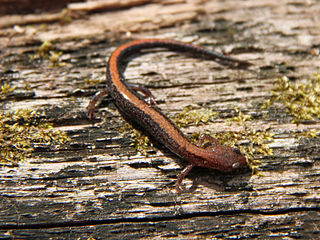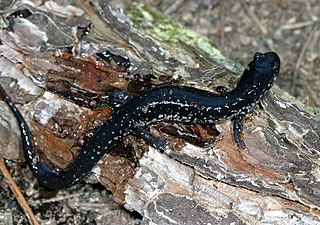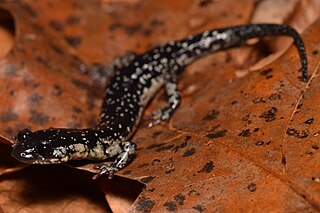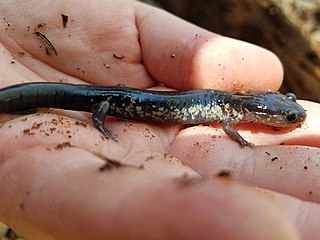
Plethodon is a genus of salamanders in the family Plethodontidae. They are also known as woodland salamanders or, more rarely, slimy salamanders. All members of the genus are endemic to North America. They have no aquatic larval stage. In some species, such as Plethodon cinereus, the red-backed salamander, eggs are laid underneath a stone or log. Young hatch in the adult form. Members of Plethodon primarily eat small invertebrates. The earliest known fossils of this genus are from the Hemphillian of Tennessee in the United States.

The northern slimy salamander is a species of terrestrial plethodontid salamander found throughout much of the eastern two-thirds of the United States.

The western slimy salamander, also known as the whitethroat slimy salamander or white-throated slimy salamander, is a species of salamander. It is endemic to the United States of America and found in two disjunct populations, one from Missouri to Oklahoma, and Arkansas, and another in south-central Texas.

The southern red-backed salamander is a species of salamander endemic to the United States. It is found in four widely disjunct populations: one in central Louisiana; one in the Ouachita Mountains of Arkansas and Oklahoma; one in central Missouri; and one from southeastern Tennessee, to southwestern North Carolina, western Georgia, and eastern Alabama. It is sometimes referred to as the Georgia red-backed salamander or the Ouachita red-backed salamander. It was once considered a subspecies of the red-backed salamander, Plethodon cinereus.
The Tellico salamander is a small woodland salamander resembling Plethodon glutinosus found in mountainous and lowland regions of southeastern Tennessee and extreme southwestern North Carolina. Little has been published on the species.

The white-spotted slimy salamander is a species of salamander in the family Plethodontidae endemic to the Eastern United States. It is one of 55 species in the genus Plethodon, and was one of the first to be described of its cogeners.

The Cumberland Plateau salamander is a species of salamander in the family Plethodontidae. It is endemic to the Cumberland Plateau, the southeastern United States. Its natural habitat is temperate forests. It is threatened by habitat loss.
The Kiamichi slimy salamander is a species of salamander in the family Plethodontidae endemic to the United States, has a natural habitat of temperate forests, and is found over a small range. This nocturnal species is mainly threatened by habitat loss and was first described by Highton in 1989. It is rated as a vulnerable species by the International Union for Conservation of Nature.

Plethodon punctatus, commonly known as the Cow Knob salamander or white-spotted salamander, is a species of salamander in the family Plethodontidae. It is endemic to high mountain forests on the border of Virginia and West Virginia in the United States. Nearly all occurrences are on Shenandoah Mountain, Nathaniel Mountain and Great North Mountain in George Washington National Forest. Cow Knob salamanders are a member of the P. wehrlei species complex, which includes many other Appalachian salamanders historically referred to Plethodon wehrlei.
The Sequoyah slimy salamander is a species of salamander in the family Plethodontidae.

The southern Appalachian salamander is a species of salamander in the family Plethodontidae.

The Webster's salamander is a species of salamander in the family Plethodontidae. It is endemic to the southeast United States, in patchy and disjunct lowland subpopulations ranging from South Carolina to Louisiana. Its natural habitat is mixed mesophytic temperate forests, in association with rocky streams and outcrops.
The Mississippi slimy salamander is a species of terrestrial plethodontid salamander found throughout most of the U.S. state of Mississippi, western Alabama, western Tennessee, far western Kentucky, and eastern Louisiana. The Mississippi slimy salamander is part of the larger slimy salamander complex.

The Chattahoochee slimy salamander (Plethodon chattahoochee) is a species of salamander in the family Plethodontidae. It is endemic to the Appalachian Mountains in the United States, where it is found only in the Chattahoochee National Forest and Nantahala National Forest in the states of Georgia and North Carolina. Its natural habitat is temperate forests. It was once classified within the northern slimy salamander (P. glutinosus) until it was found to be a distinct species. Its range narrowly intersects with the northern slimy salamander, the Atlantic Coast slimy salamander (P. chlorobryonis), and the southern Appalachian salamander (P. teyahalee) and widely intersects with the red-legged salamander (P. shermani), and it is known to hybridize with the latter three.

The southeastern slimy salamander is a species of salamander in the family Plethodontidae. It is endemic to the United States, where it is distributed in the Southeastern United States from southern Georgia west to Alabama and south to central Florida. Its natural habitats are steephead valleys, maritime forests and bottomland hardwood forests. Initially identified as a subspecies of P. glutinosus, P. grobmani is named for American zoologist Dr. Arnold B. Grobman.
The Ocmulgee slimy salamander is a species of salamander in the family Plethodontidae. It is endemic to the state of Georgia in the United States, where it is found in regions of the coastal plain and Piedmont that are associated with the Ocmulgee River drainage system. It is only known from a few counties, and due to this restricted range, it is at high risk of extinction. Many populations of this species are already experiencing precipitous declines, with some even possibly being extirpated.
The Savannah slimy salamander is a species of salamander in the family Plethodontidae. It is endemic to the state of Georgia in the United States, where it is restricted to the Atlantic coastal plain in Burke, Jefferson, and Richmond counties. This distribution reaches its eastern limit at the Savannah River. Its natural habitat is bottomland hardwood forest. Population analysis indicates a precipitous decline in the population of this species, and it is becoming extirpated in many areas due to development; for example, the habitat at the type locality of this species was partially destroyed by a housing development.

The South Carolina slimy salamander is a species of salamander in the family Plethodontidae. It is endemic to the south-eastern United States, where it is restricted to a small portion of the Atlantic coastal plain from South Carolina to extreme south-eastern Georgia. Its natural habitats are mixed forests, bottomland hardwood forests, and longleaf pine savannas.













